Climate Change: What Is It and Why Does It Matter?
11 minute read
Updated on: 25 Sep 2021
Let’s start with the most obvious question: why does climate change matter? In short: because it will hurt humans, animals, and loads of other living things.
For humans, climate change will be felt as:
- Not enough food and water
- More people becoming refugees
- More health problems
- Negative impacts of peoples jobs and livelihoods
So let’s dive in and learn why we need to care about climate change.
Let’s start with food. Food is important.
The plants we grow for food, including things like wheat (which makes bread), rice, vegetables and fruit are known as crops.
In some places, and for some types of crops, climate change will increase growth . This is because warmer temperatures and higher CO₂ make for better growing conditions in places such as Europe
. However, most places won’t be able to grow as much food
.
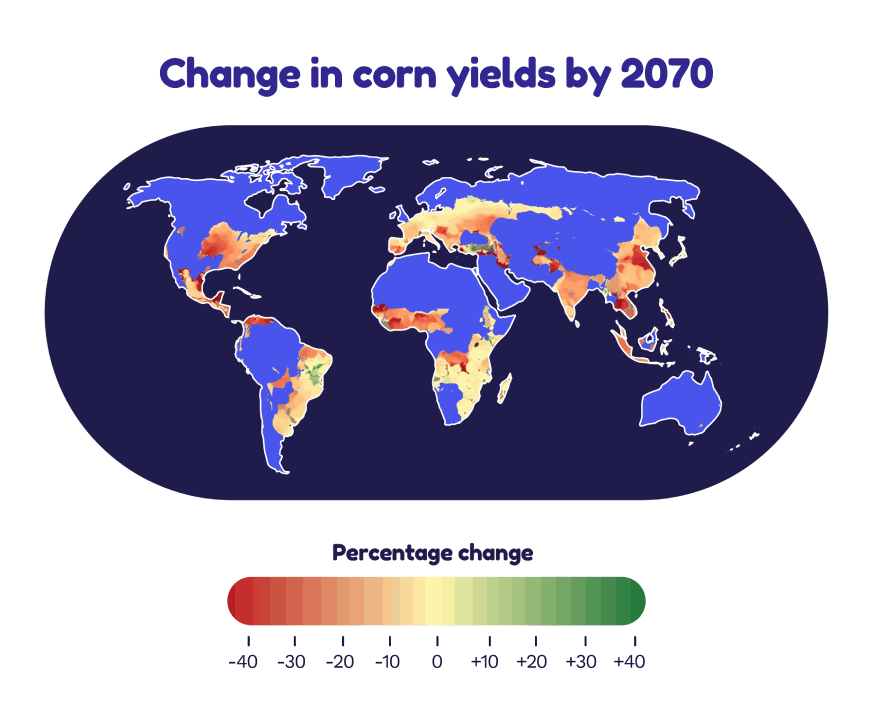
Crops will increase in some places but decrease in most places
Climate change will affect water as well as food. Like with crops, the effects will be different in different places
. Wet areas will get wetter and dry areas will get drier - meaning more flooding and more droughts
. Other types of weather will be more extreme too: heatwaves and storms are both expected to get worse. All of these things will damage people’s health - and on top of this, the changes in climate will change how some diseases (like malaria and cholera) spread
.
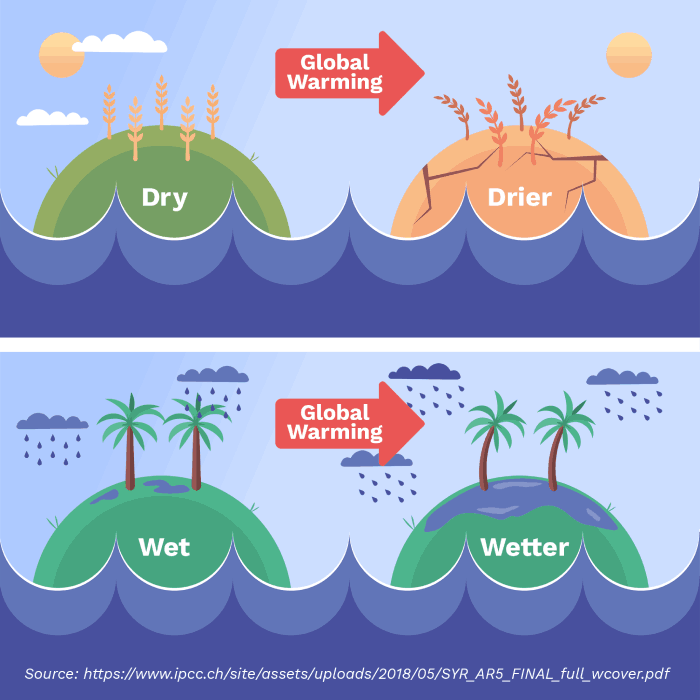
Wet places will get wetter and dry places will get drier
Some people may be forced to leave their homes and become climate refugees. This could be due to flooding, storms, droughts or conflicts driven by climate change, which make it impossible to keep living where they are
.
These impacts will be very costly for nations and individuals - particularly those which are poorer . In fact, about 75-80% of the costs of climate change will be paid for by poorer countries
. So even though inequality between rich and poor countries may have decreased in recent decades, global warming is slowing, and may even reverse this progress
.
What about other living things on Earth?
Climate change isn’t just bad news for humans. Many living things (like animals and plants) will have to move or change in order to survive. If they can’t, they’ll die out
. When all of a certain type of animal or plant die out, this is called extinction.
Living things are already going extinct at a very high rate, mainly because of other human activities like killing and habitat destruction . Climate change will only make this worse, and lots of extinctions cause huge problems for both nature and humans
.
So, why is all this happening?
To find solutions to climate change, we have to begin by understanding the problem.
The climate has gone through many periods of cooling and warming, so what’s so special about it this time ? Well, the changes we are seeing today are happening much faster than they would naturally
.
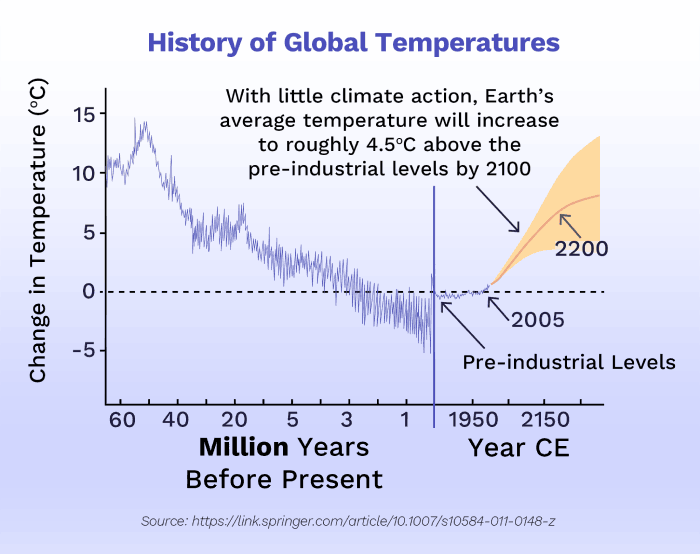
Earth is warming at a much faster rate
In the past, these changes happened over thousands to millions of years .
How did we get here?
It all really comes down to something we call the greenhouse effect. The greenhouse effect involves certain gases in the atmosphere called greenhouse gases, which include carbon dioxide (CO₂), methane (CH4) and many others. Adding more of these gases to the atmosphere heats up the planet
.
These gases are found in nature, but it’s humans releasing additional CO₂ and other gases into the atmosphere that has sped up the greenhouse effect and led to the warming we see today .
What is the greenhouse effect?
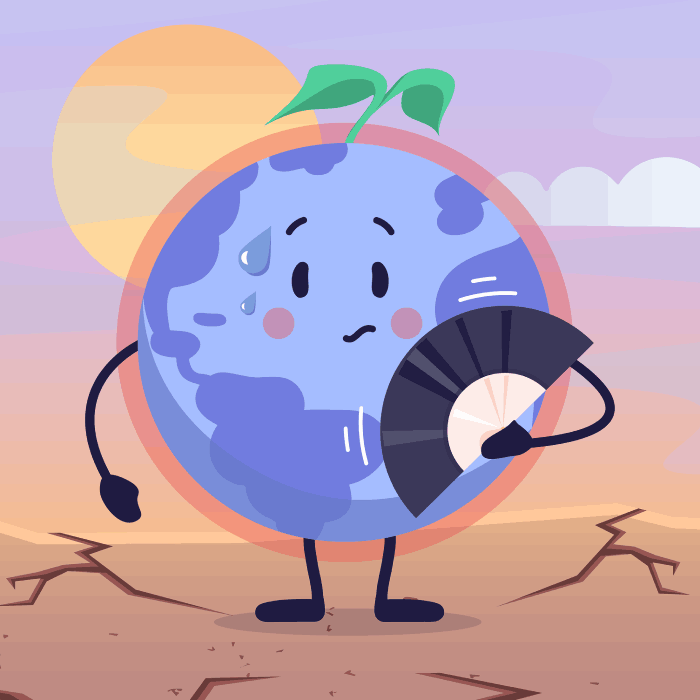
Radiation from the Sun is what makes the Earth warm .
Some of this radiation is absorbed by the atmosphere and some of it is reflected back into space by clouds . Most of it passes straight through the atmosphere and is absorbed by the Earth’s surface
.
This absorbed energy is emitted from the surface as infrared radiation which is then absorbed by what we call greenhouse gases
. These gases reradiate the infrared waves out in all directions – some into space and some back to Earth
.
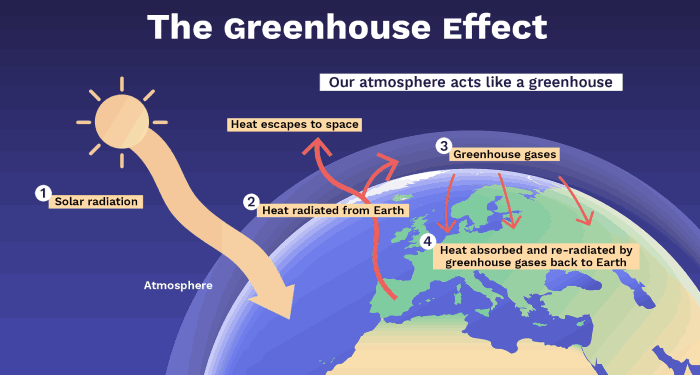
The greenhouse effect in action
The infrared radiation that does hit the earth causes further warming at the surface and lower atmosphere . This extra warming is called the greenhouse effect because heat becomes trapped, just like it does inside a greenhouse
!
Where do humans come in?
Human activities release lots of greenhouse gases which speeds up this process .
Without the greenhouse effect, the average temperature on Earth would be -18°C! So it’s not the presence of greenhouse gases that’s the problem, but rather the abundance.
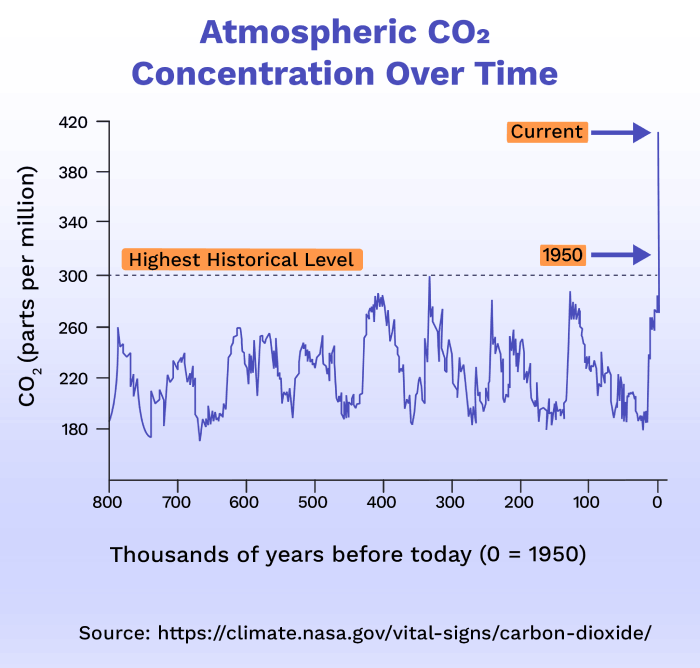
The problem is the abundance of greenhouse gases
What’s emitting all these greenhouse gases?
Let’s look at what human activities are emitting greenhouse gases. On the left, we can see which sector the gases come from, and on the right, we can see what they end up being used in
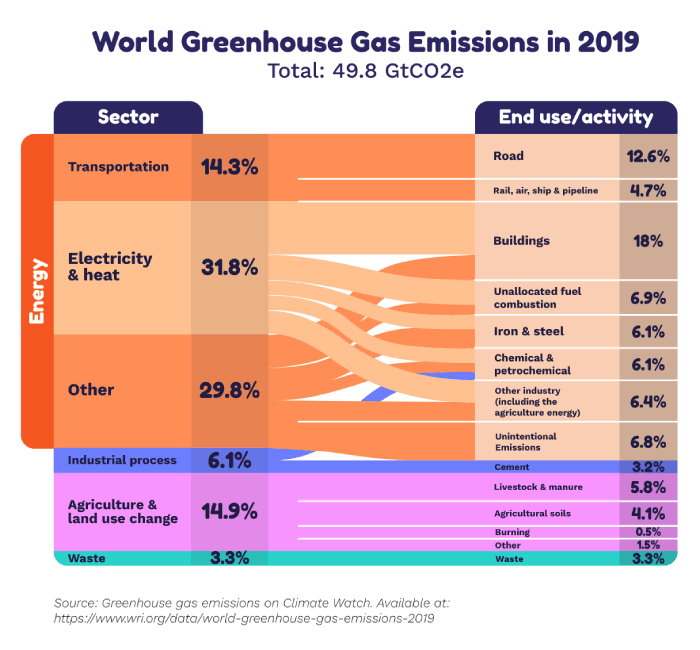
World greenhouse gas emissions split into source and end use
You can see from the left side that the energy sector produces 73% of greenhouse gas emissions (adding transportation, electricity & heat, and other). This makes energy the number one climate problem .
Burning fossil fuels makes up the majority of global energy. These fuels are a good way to store energy in a small space, but burning them releases lots of CO₂
.
Emissions also come from other sectors like farming, industry and waste.
So how do we solve this? Let’s take a look at our climate equation!
The climate equation
Our greenhouse gas emissions are the result of individual people doing activities . Each activity releases emissions when done, and each product releases emissions when used, made and transported
.
So total emissions depends on three things :
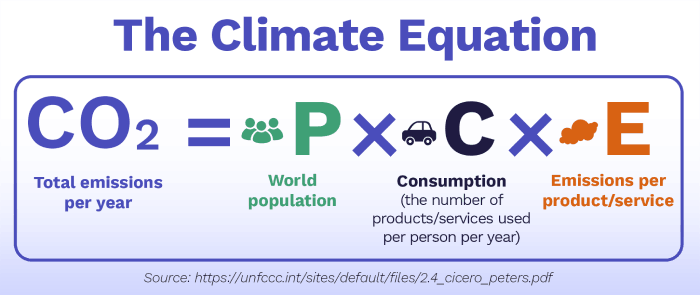
The climate equation can help us figure out how to solve climate change
To stop causing climate change, we need to try and bring “total emissions” as close as possible to zero.
If we could bring P, C, or E down to zero, then we would have no emissions. It’s basic maths: multiply anything by zero and you’ll get zero.
Let’s explore those three options.
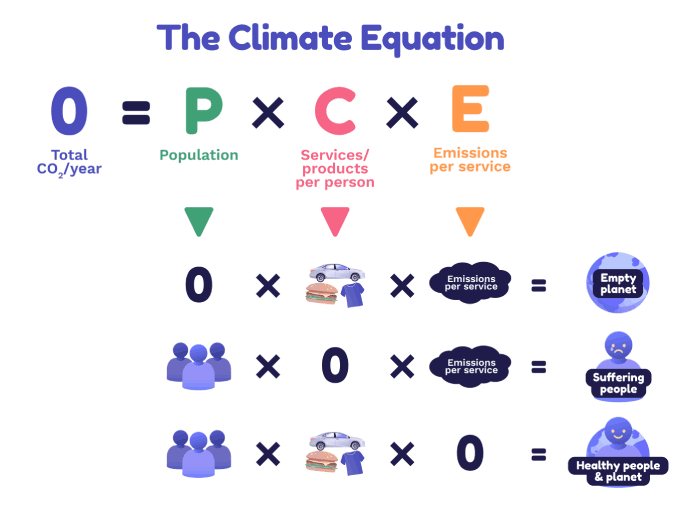
Three options to reach zero emissions with the climate equation
An empty planet and suffering people aren’t good options, so we need to try to reduce our emissions per service (E) in order to solve climate change .
However, there are some products where it’s flat out impossible to get the emissions to zero (for example, cement and beef). Where this is the case, and where it’s possible to reduce consumption without causing suffering, we should also try to do this. Reducing consumption will also help reduce emissions while we work on getting emissions per service to zero.
There are many people who don’t consume much to start with, and others who consume a lot! So…
Why are some people more responsible than others?
From the causes to the effects, climate change is very much marked by inequality.
As you can see in the image below, the richest 10% of people contribute more CO₂ than everyone else combined !
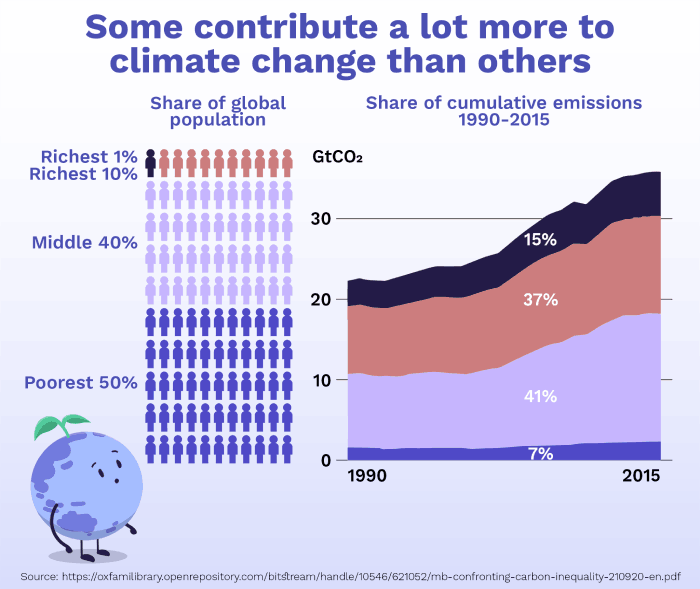
Some contribute a lot more to climate change than others
And not just that, the people who have contributed to climate change the least will be affected the most by its effects. Areas with weak health infrastructure will struggle the most to prepare and respond effectively to threats to health like extreme weather events . These areas are also likely to be impacted by increased poverty, lack of resources, and migration due to climate change
.
This inequality is also the case between countries .
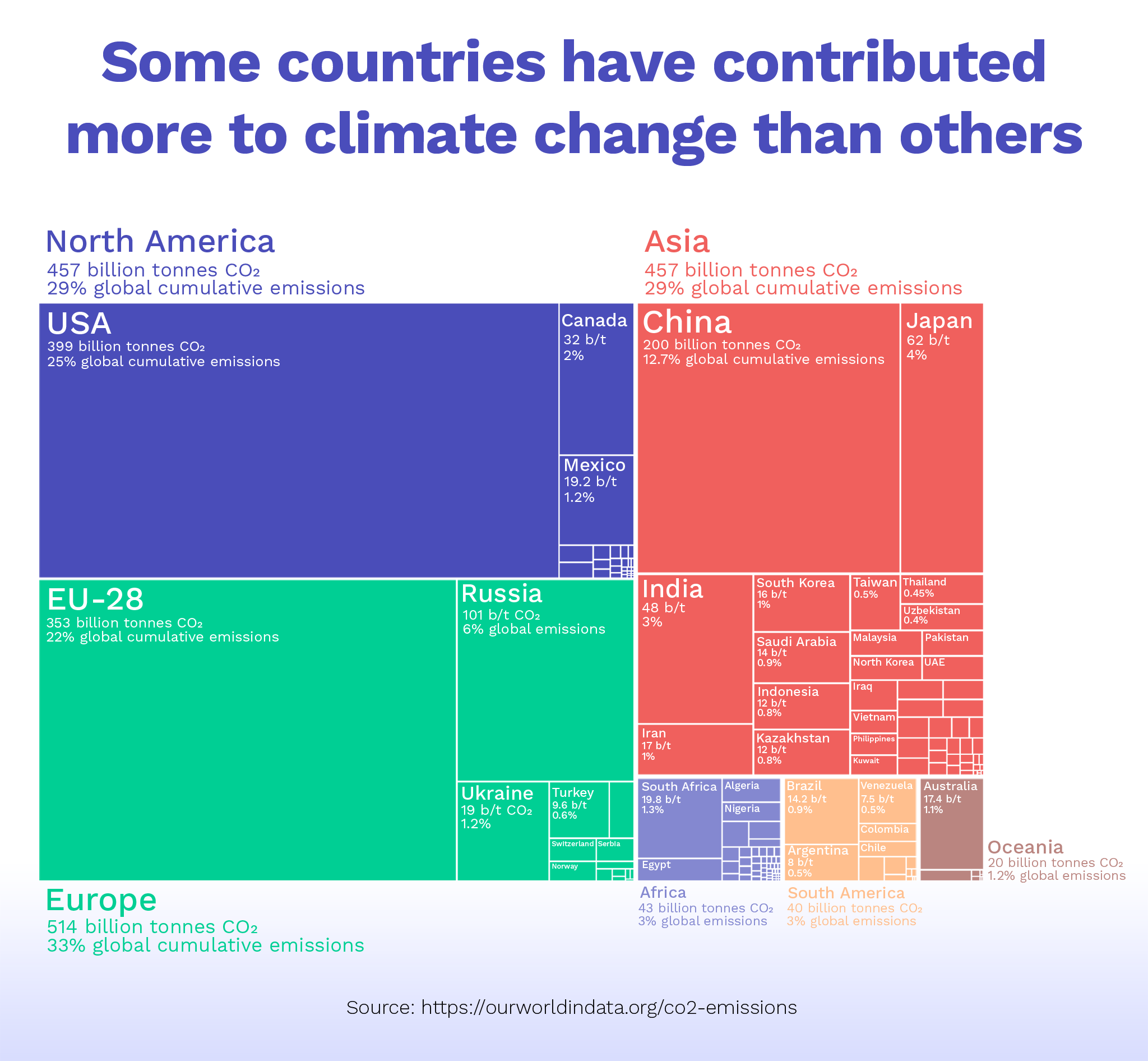
Some countries have contributed more to climate change than others
The United States, EU countries, and China are the biggest contributors to global emissions . The US and EU countries are also the best prepared to deal with the effects of climate change
.
At the same time, countries across Africa and Southeast Asia will be much more vulnerable and less able to adapt even though they contributed the least .
Conclusion
Now we know what climate change is, how it’s going to affect people and the planet, and who has contributed to it. We also know that we need to reduce emissions per service. Let’s take a look at the number one climate problem - Energy - to figure out how we can effectively do this.
Next Chapter